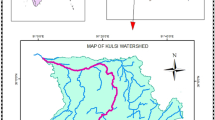Abstract
This paper focuses on the application of the modeling techniques and the numerical method to simulate the flood discharge and the water depth in rivers with floodplains. Both the overland and the river flow are considered and the momentum exchange is taken into consideration. Cubic-spline interpolation technique is used to interpolate between the geographic data of the rivers’ cross-sections containing eleven pairs of X–Y points and to calculate the properties of the river cross-sections and their derivative values. A numerical solution of Saint Venant equations with lateralflow is presented for the river network. Observed data in a part of Arakawa River basin in Kanto area, Japan, are used to validate the program. The simulated values show good and acceptable agreements with the observed ones. The diffusive model is suitable for the hill areas and the steep slopes while the dynamic model is suitable for the river flow with high water depths, the flat areas and the mild slopes. The lateral flow and roughness coefficient have significant effects on the simulated resultes.
Access this chapter
Tax calculation will be finalised at checkout
Purchases are for personal use only
Preview
Unable to display preview. Download preview PDF.
Similar content being viewed by others
References
Amein M, M ASCE Fang C S (1970) Implicit flood routing in natural channels, Journal of the Hydraulic Division, ASCE, Vol. 96, No. HY12, pp. 2481–2500
Bousmar D, Zech Y (1999) Momentum transfer for practical flow computation in compound channels. J. of Hydraulic Eng., ASCE, Vol. 125, No. 7, pp. 696–706
Chow V T, Maidment D R, Mays L W (1988) Applied Hydrology, McGraw-Hill Series in Water Resources and Environmental Engineering, Chapter 10, pp. 310–339
Franz D D, Melching C S (1997) Full equations (FEQ) model for the solution of the full dynamic equations of motion for one-dimensional unsteady flow in open channel through control structures, U.S. Geological Survey Water-Resources Investigations Rep. 96-4240 http://water.usgs.gov/software/code/surface_water/feq/doc/fe q.pdf
Fread D L (1973) Technique for implicit dynamic routing in rivers with tributaries, Water Resources Research, Vol. 9, No. 4, pp. 918–926
Jha R, Herath S, Musiake K (2000) Application of IIS Distributed Hydrological Model (IISDHM) in Nakhon Sawan Catchment, Thailand, J. of Hydroscience and Hydraulic Eng. Vol. 18, No. 1, pp. 21–27
Jha R, Herath S, Musiake K (2000) River network solution for distributed hydrological model and applications, Hydrological Process, Vol. 14, pp. 575–592
Luo Q (2000) A distributed water balance model in large-scale complex watersheds (LCW) and its application to the Kanto Region, Ph.D. dissertation of the University of Tokyo, Tokyo, Japan
Luo Q, Toshio K, Toshimitsu T (2003) The basin-wide two-dimensional model of sediment production and transportation for estuary sediment simulation, Int. Conference on Estuaries and Coasts, pp. 847–857
Luo Q (2007) A distributed surface flow model for watershed with large water bodies and channel loops, J. of Hydrology Vol. 337, pp. 172–186
Mayers R C, Lyness J F (1997) Discharge ratios in smooth and rough compound channels, J. of Hydraulic Engineering, ASCE, Vol. 123 No.3, pp. 182–188
NOAA National Oceanic and Atmospheric Administration’s, National Weather Service, DWOPER Dynamic Wave Routing
manual/part2/_pdf/24dwoper.pdf
River Bureau, Ministry of Land, Infrastructure and Transport, Japan, Land and climate of Japan, Characteristics of rivers in Japan
http://www.mlit.go.jp/river/english/land.html
Seckin G (2004) A comparison of one dimensional methods for estimating discharge capacity of straight compound channels, Canadian J. of Civil Eng. 31, pp. 619–631
Wormleaton P R, Allen J, Hadjipanos P (1982) Discharge Assessment in compound channel flow, J. of Hydraulic Division, ASCE, Vol. 108, No. HY9, pp. 975–994
Wormleaton P R, Merrett D J (1990) An improved method of calculation for steady uniform in prismatic main channel/floodplain sections, J. of Hydraulic Research, Vol. 28, No. 2, pp. 157–174
Yagisawa J, Tanaka N, Luo Q, Takagi T, Tamai N (2005) Application of the distributed water and sediment balance model including dam construction effect to the Arakawa river Basin, Proc. 7th Int. Summer Sym., pp. 129–132
Author information
Authors and Affiliations
Rights and permissions
Copyright information
© 2009 Tsinghua University Press, Beijing and Springer-Verlag GmbH Berlin Heidelberg
About this paper
Cite this paper
Hassan, A., Tanaka, N., Tamai, N. (2009). Distributed Water Balance Model in Watershed Coupling with River Dynamic flow Routing Method. In: Advances in Water Resources and Hydraulic Engineering. Springer, Berlin, Heidelberg. https://doi.org/10.1007/978-3-540-89465-0_3
Download citation
DOI: https://doi.org/10.1007/978-3-540-89465-0_3
Publisher Name: Springer, Berlin, Heidelberg
Print ISBN: 978-3-540-89464-3
Online ISBN: 978-3-540-89465-0
eBook Packages: EngineeringEngineering (R0)




